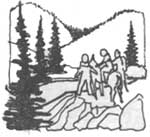|
The Clearwater Story: A History of the Clearwater National Forest |

|

Chapter 4
John Work
By 1831 the competition between the Hudsons Bay Company and the American fur trappers for the fur trade had become quite keen. This was especially true in Montana, Wyoming and South Idaho. To challenge the fur traders in this area and to discourage further United States expansion westward, John Work or Wark, left the Hudsons Bay post at Vancouver, across the Columbia River from present Portland, in the fall of 1831. His party of between 35 and 60 men, women, and children, including his wife and three daughters, reached Weippe on Sept. 26, 1831. There were Indians at Weippe and they attempted to trade with them but they found the Nez Perce not interested in beaver trapping and hard bargainers when it came to trading horses.
Sept. 30, 1831. They moved to a little valley the country there had been burned and was pretty bare of wood. This, in my opinion, was Browns Creek, although some consider it Musselshell. My opinion is based on the age of the timber. The trees at Musselshell before harvest in the 1950s were over 200 years old; those at Browns Creek about 130.
October 1, 1831. According to the log of the journey "It began to snow in the night and snowed all day." It is very unusual for snow on October 1 at this elevation, but not for the Lolo Trail.
October 2. The party started over the Lolo Trail and made 24 miles "over very steep hills and thick woods" and "encamped in a deep valley." Here there was no grass and the horses ate "bramble and briars. We have now fallen on the great road."
Some say that this camp was at Deep Saddle and the description would fit except for the statement that they had reached the "great road". This would have to be the trail as followed by Lewis and Clark and that makes it Sherman Saddle, since the trail followed by Lewis and Clark turned down into Hungery Creek on the ridge west of Sherman Saddle. There are no clues as to where the trail followed by Work ran, but apparently it was close to the Lolo Trail as established by Bird in 1866.
October 3. The party made 17 miles through 9 inches of snow and camped by grass. This puts them at Bald Mountain.
October 4. Storms prevented travel. The day was spent looking for missing horses.
October 5. More snow fell. The party moved 15 miles, which put them at Camp Howard. There was grass covered with snow, "so the starving horses could not get it."
October 6. The snow continued and more horses were lost. One horse died, another "gave up." The location of their camp is uncertain, but it appears to have been at Cayuse Junction.
October 7. Stragglers catching up with the main party report six feet of snow on the higher elevations to the west. This would be Indian Post Office and Spring Hill. Less than a foot of snow at the camp site. There is no horsefeed at Cayuse Junction.
October 8. The snow turned to rain as they move to a lower elevation. They made 15 miles and camped on Crooked Creek. Again, no horsefeed.
October 9. Eight miles further and they reached Packer Meadows. "There is a good deal of good grass for the horses, of which they are in much need." Here they camped for three days to rest and give the horses an opportunity to feed on good grass.
October 13. They move to "a small plain at a hot spring." This is Lolo Hot Springs.
Thus the second known white party crossed the Lolo Trail. They found it just as difficult as their predecessors, Lewis and Clark. They returned to Vancouver by way of South Idaho.
| <<< Previous | <<< Contents>>> | Next >>> |
|
clearwater/story/chap4.htm Last Updated: 29-Feb-2012 |